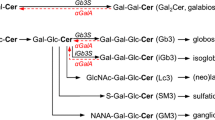Abstract
Sphingolipid activator proteins (SAPs) A to D are lysosomal factors required in degradation of sphingolipids with short hydrophilic head groups and are derived from a precursor protein. Sap-B deficiency causes a variant of metachromatic leukodystrophy and sap-C deficiency causes a variant of Gaucher disease. Human total SAP deficiency has been reported in two patients in a single family. In these cases, various inclusions were described in the liver, skin, muscle and peripheral nerves ultrastructurally, but there was no report on the pathological study of the central nervous system (CNS). With targeted disruption of the precursor protein gene, we have generated mice with total SAP deficiency. These mice developed progressive neurological symptoms around day 20 and could not survive beyond day 40. Their cardinal pathology is extensive neurovisceral storage. Neuronal storage was already detected in the dorsal root ganglia as early as postnatal day 1 and diffuse neuronal storage was detected in the CNS after day 10. This storage was immunoreactive with anti-ubiquitin antibody and ultrastructurally appeared as inclusions consisting of numerous concentric lamellar and dense granular structures in the perikarya as well as in dendrites and axons. Axonal spheroids containing electron-dense concentric lamellar bodies and neurofilaments were also conspicuous. The extent of neuronal storage, numbers of storage neurons and axonal spheroids increased with age, accompanied with hypomyelination, astrogliosis and increase of macrophages. After day 30, argyrophilic tangle-like structures, which were immunoreactive with an antibody to phosphorylated neurofilaments, were found in the perikarya of many spinal and some neocortical neurons. Inclusions with various ultrastructural features were also noted in the glial cells, choroid plexus epithelial cells, vascular endothelial cells, Schwann cells, macrophages, fibroblasts, hepatocytes, and renal tubular epithelial cells. Some inclusions in the visceral organs were closely similar to those described in human cases of total SAP deficiency. The ultrastructural features of these inclusions in SAP knockout mice appeared unique and were different from those of other known sphingolipidoses.
Similar content being viewed by others
Author information
Authors and Affiliations
Additional information
Received: 4 November 1997 / Accepted: 10 December 1997
Rights and permissions
About this article
Cite this article
Oya, Y., Nakayasu, H., Fujita, N. et al. Pathological study of mice with total deficiency of sphingolipid activator proteins (SAP knockout mice). Acta Neuropathol 96, 29–40 (1998). https://doi.org/10.1007/s004010050857
Issue Date:
DOI: https://doi.org/10.1007/s004010050857




